| TOP > FEATURED VEHICLES > RE Amemiya GReddy D1 RX-7 FD3S |
| RE Amemiya GReddy D1 RX-7 FD3S From Drift Tengoku |
 |
| During a full year of participation in the D1 series, the reputable rotary tuning shop RE Amemiya has gone through many ups and downs. The new machine was introduced in the 3rd round of this season, which was constructed according to various data gathered throughout their participation in the series. This new machine ditched its concept of time attack, but rather increased its characteristic of speed, angle, strength, and controllability. |
The weakness of the original machine was the vehicle angle |
|
| The new machine was introduced at Ebisu Circuit right before the 3rd round of ongoing series at Sugo. Suenaga's stated "it was built just the way I requested and was great from the beginning." The only major modifications were the relocation of the fuel tank and side porting of the motor. That alone made the car easier to drift because of reduced rear weight, yet decreased the possibility of spinning out. The power increase meant more smoke during hard drifting. Suenaga said he was able to put out his best performance of his career at Sugo with his new machine. RE Amemiya started participating in D1 starting with an exhibition run that took place last April. They are experienced in grip racing but still lacked knowledge in the sport of drifting. The first machine was created based on a high speed time attack grip machine, with an exclusive roll cage setup that was ideal for this style of racing. The turbine and the suspension configuration were the same of time attack machines as well. Full pillow arms, other various parts that provide more structural rigidity, and racing stabilizers were also installed. Suenaga's opinion of the first machine was "it is an extremely difficult machine to drift with.I had a hard time getting the car sideways because the machine was made to grip very well." | The car in fact, is very difficult to break lose but once it does, the machine showed its potential at drifting at high speeds; especially at shallow angles because of the great traction. If Suenaga took it further and attempted to get more angle from the car, it would end up spinning out. Team Amemiya couldn't produce any good results except for raking in at 8th at the 2nd round. There, out of sheer luck, the tire pressure and the suspension settings were just perfect at the time. It was important but very difficult for Suenaga to grasp the characteristics of the FD3S, and for his mechanics to understand the necessary aspects involved in drifting. The team started to improve from the 6th round after not scoring any points from 3rd round due to the rear traction issue. Soon after, the mechanics started to become in sync with Suenaga's expectations. From there, the rear camber was reduced to less than 2 degrees. The ability to control the sliding started to improve upon the increased height of the rear and by altering of the dampening force; enabling more strut stroke. As a result, Suenaga won the tsuisou battle in the final round to place 7th in overall in the series. |
The setup Suenaga requested was very close to stock settings?!
Since the year started off with an overseas season opener, it was very difficult to setup the machine properly. Despite that, Suenaga managed to place 6th because the embankment made it difficult for his machine to spin out. RE Amemiya made an important decision upon returning to the states. The Quantum coilovers that they had installed weren't fully adjustable, which limited the range of adjustability so they switched to DG-5 units from Kei Office Planning. |
The same image as their time attack vehicle but targeted more for the streets |
|
| The RE Amemiya team spent a full 2 days at Ebisu circuit for some heavy testing and tried various suspension setups. The outcome of the testing was astonishing. The dampening force on the suspension was now softer and the stock sway bars were reinstalled. They also realized that they had better control with stock bushings. The more Suenaga's machine became closer to the stock settings, the easier it was for him to control. Suenaga ranked in at 5th despite losing the competition to HKS on the 2nd round. The machine had improved tremendously, yet there still was a problem; the weight ratio of the machine. Generally, a FD3S has great cornering qualities because of its even weight distribution of 50:50. But that also forces the vehicle to spin out easier. | The request from Suenaga to solve this problem was to reduce the weight on the rear.It was made possible by relocating the fuel tank. This modification held a possibility of FD's great potential of traction quality, but it didn't seem to be a problem because it was already controlled by the suspension settings. Despite of the speculation, the machine became more tolerant to bigger angle. Suenaga was able to perform his best with high speed, traction, and never-seen-before drifting angle and smokes at 3rd round. As of now, RE Amemiya team and the drivers are in great sync with the understanding of the machine and its characteristics. RE Amemiya is moving forward in creating a new world of drift specs in FD3S's. |
 |
ENGINE
The stock motor on the first machine was modified with side board on the second
machine to increase power in all rpm ranges. Power band is from 4500 to 9000rpm.
Smaller turbine will be best suited for better response, but its focal point
was geared toward power upon Suenaga's request. |
 |
ENGINE
Radiator and Intercooler were V-mounted. The change was made to have a different
appearance compared to the vertical mount on the first machine. The power steering
oil cooler was placed above radiator. |
|
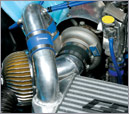 |
ENGINE
TD07-25G turbine was installed. The exhaust housing was rather big which is in size of 22cm. Those modifications were aimed toward creating more power at higher RPM rather than full torque at lower RPM. Another goal was to have smoother connection of the gears by shifting it at higher RPM. |
|||
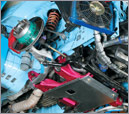 |
SUSPENSION
Suspension member has not changed regardless of of its color. First machine had pillow ball mount but was changed to stock bushing except for lower arm on the rear. These modifications were made for easing the control of the drivers. There is no visible scratch on the plate below the member for oil-pan protection. Front wheel was installed with 25mm spacer in between.
|
 |
SUSPENSION
To prevent the better angling tires from touching the tire housing, necessary body panels have been modified within tire housing. There also was modification on the upper arm panels to cover its weakness. These two are the only modification to the body. The turning radius has been increased by integrating knuckles from Satoru works and tyrods from URAS.
|
|
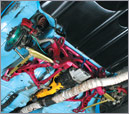 |
SUSPENSION
There is a little modification on the mission mount on rear suspension member.
Trust's differential cover allows bigger oil capacity by 1 liter and also prevents
oil temperature from overheating. Power plant frame is an original product from
RE Amemiya for increasing rigidity. The spring ratio is often changed; front
is constant at 16kg/mm, and rear is changed within the range of 12-20kg/mm. Front
rotors used are 16 inches, but 17inchs are used for rear to increase the e-brake
function. |
|||
 |
INTERIOR
The steering wheel location was adjusted with spacer upon Suenaga's request.
He is very sensitive with his machine setups. The dial for brake balancer is
visible on the side of center consol. The rear brake has more gripping pads so
the wheels would lock easier when e-brake is used. But the balancer was used
to adjust the braking toward the front because rear brake works too well when
foot brake is used. They focused more on control than gripping on the front brake
pads.
|
 |
INTERIOR
Amemiya's boost meter is installed in the center consol. And there is a switch
for electronic fan for oil cooler next to the boost meter. Another switch for
electronic fan for radiator is located next to Pro Check's monitor. F-con
V pro and Power FC was installed on the passenger seat where mechanics can easily
reach. Power FC is only used for controlling metal oil pump and idling valve.
The added meters on the passenger sides are for water temperature, oil temperature
and oil pressure gage.
|
|
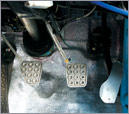 |
INTERIOR
The heat insulator was placed since undercoat was taken out. It would heat up
to where the sole of the shoe would melt without the insulator. Foot pedals were
made by the team upon Suenaga's request.
|
|||
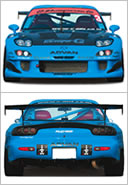 |
EXTERIOR
All body kits are RE Amemiya original products; Facer N1 for the front bumper, AD hood 9 for the hood, front and ADGT kit that includes front/rear fender and side steps, diffuser, Sleek Headlight kit, and GT wing. Each side of the body added 2mm to its width, which prevents from tires touching the body at full counter and providing more tred for better cornering performance.
|
|||
| Contact: RE Amemiya http://www.re-amemiya.co.jp | Back to the top |